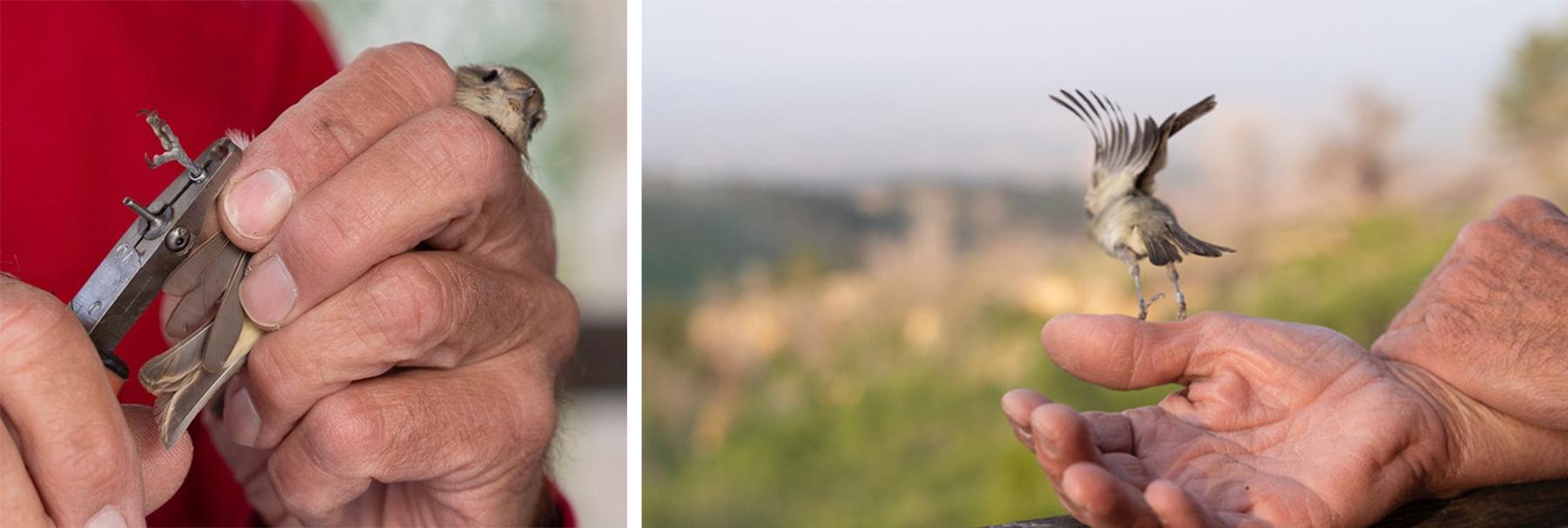A Bird In Hand

By Ellis Hein
When I was young, my life’s ambition was to catch a sandhill crane. Every year during fall migration we saw thousands of cranes migrating south over our farm in the Oklahoma Panhandle. If the winter wheat had grown enough to make the fields inviting to tired and hungry cranes, they would spend the night feeding and resting. My idea was to ride my horse at a dead run over a small rise and get in among the cranes before they could fly. Then I could catch one before they all got away. I am probably alive today because of many failures. Now, some 60 years later, I still find cranes fascinating. But my interest is more focused on small birds.
In my recent article, Tracking Wyoming’s Birds, I mentioned banding as one way to gain a picture of what is going on in avian populations. I began banding birds in 2009 at the Audubon Center on Garden Creek in Casper, Wyoming. Our children, then 16 and 14, allowed me to tag along and first instructed me in extracting a bird from a mist net—a net with threads so fine they look misty. Birds, and sometimes people, don’t see the net until too late. I had handled birds for most of my life, caring for poultry, raising several species of wild birds and doctoring injured wild birds. But banding is different.
While the sensation of having a bird in hand was not new, this certainly was a new dimension. You gradually realize that you hold the life of not just this individual but, in a way, of the species. But it’s more than that. On some level you hold your own life as well, since your wellbeing is not separated from the bird’s. The old saw, “A bird in hand is worth two in the bush” has to do with procuring food. But when you are banding, you’re giving rather than taking. You’re interacting with a being whose ancestors sang to the first humanoids on earth. This demands a certain level of respect. If you feel morally superior in this interaction, it is that in being bitten, you don’t bite back.
So how does one go from bird in air, to bird in hand and back? First we choose a likely location for each net. We set these up before daybreak and check them every 40 minutes, more often if conditions warrant. Birds flying into the net will become trapped in one of the pockets—folds running the length of the net. Some birds quietly lie there while others struggle, entangling themselves. Extracting a bird lying in a pocket is simple: Reach into the fold and carefully retrieve the bird. The tangled birds require skills that come from hours of patient training and experience. Once we have extracted the bird, we place it into a cloth bag and hang it on a shaded line to await processing. The bags keep the birds calm and the shade keeps them cool.
Processing involves many steps, starting with identifying the species, placing the band on the right leg (unless it already has a band) and determining sex. If female, is it brooding eggs? If male, is it breeding? We determine age by looking at the feathers. We also measure wing length, note body fat, check feather wear and weigh the bird. We carefully record this data and send the bird on its way. That may sound easy, and it is when you have 20 yellow warblers to process. You know exactly what you are looking at and it is easy to move quickly from one bird to the next. They don't fight. Black-headed grosbeaks are different. You repeatedly extract part of your finger from its beak—it knows the most painful spots to pinch. When you want to release it, it won’t fly away because it has pinched you again. I have never had a grosbeak draw blood. But if you have a hairy woodpecker, while you are taking data, it is busy drilling holes in your fingers. So you get to practice your superiority: You don’t bite or peck back.
Too soon the banding season ends. The summer is migrating south with all those banded birds. Fall comes again and V formations of sandhill cranes are flying over. I hear their calls and, in my mind’s eye, I am back in those Oklahoma wheat fields. But in the intervening years I have learned something. Or have I? It would be so easy to gallop over that slight rise. After all, A Bird In Hand…
